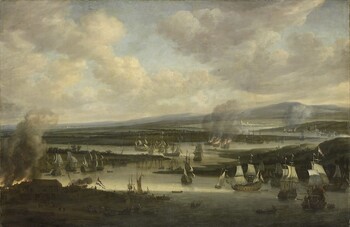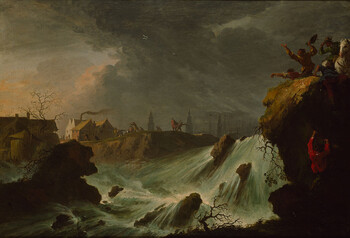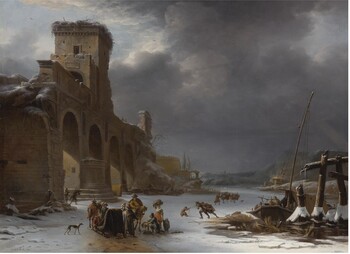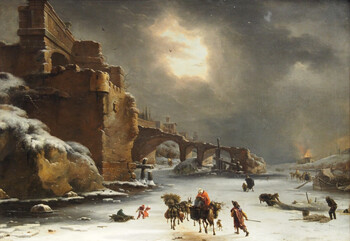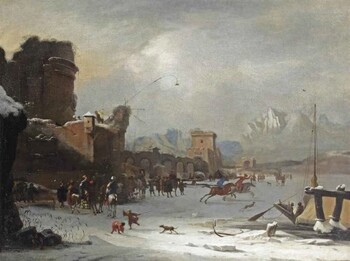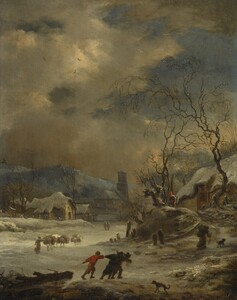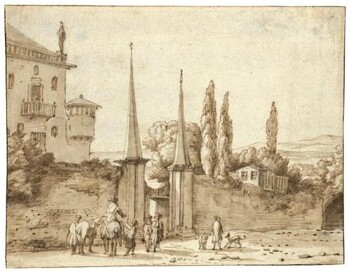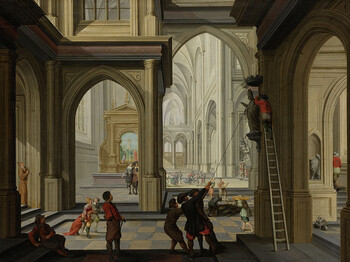Willem Schellinks
A winter landscape
Oil on panel : 27 X 21,3 cm
Unsigned
Sold at Sotheby’s London, 4/07/19
For 47.500 £ = 52. 968 €
This is a comparative item
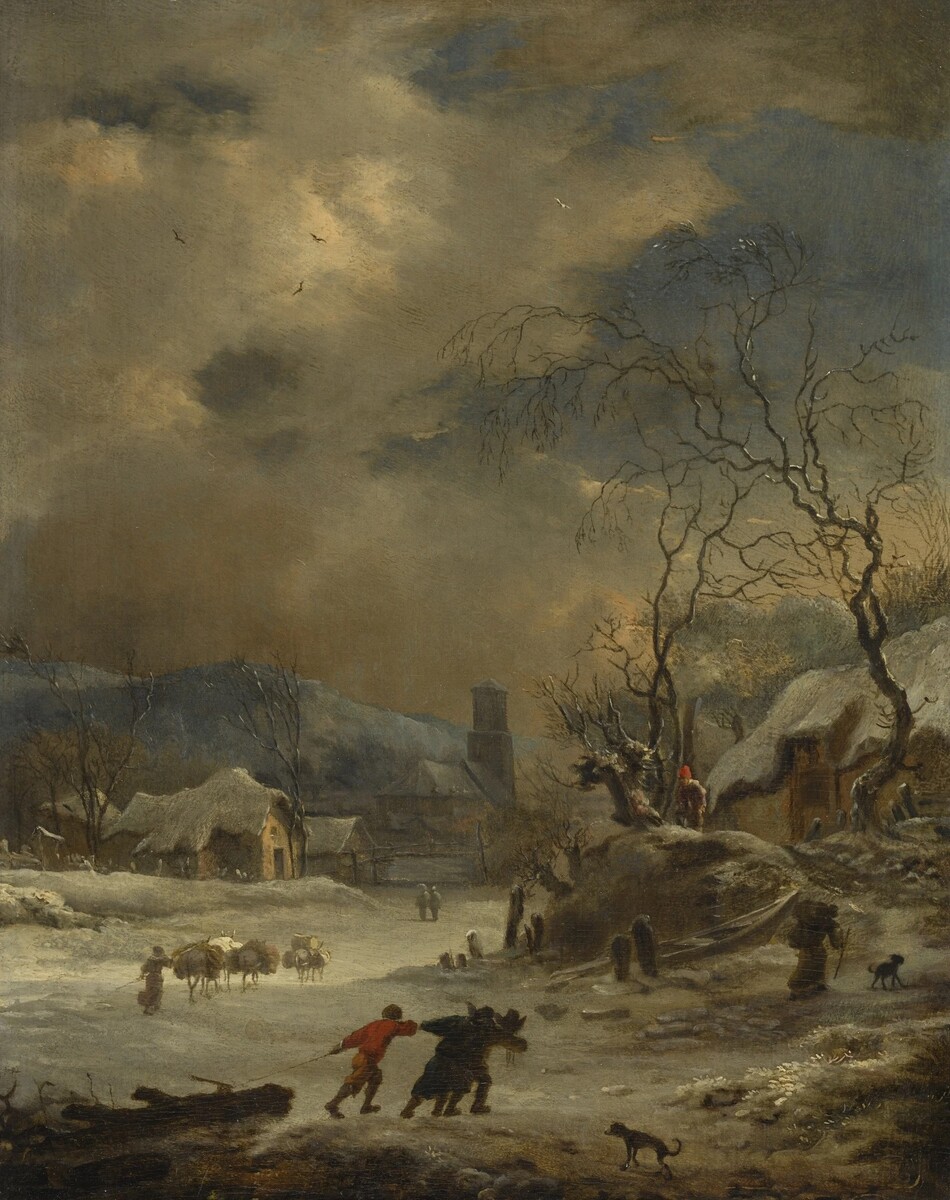
Painting for Sale
Schellinks, Willem
"Dutch soldiers plundering and burning down a church"
In short
Willem Schellinks was a well-travelled painter who is known for having painted and drawn unusual, original subjects: theatrical views of the court of the Indian Mughal Emperor Shah Jahan, the Dutch raid on Chatham, Roman winter views along the River Tiber and numerous topographical drawings (for example of Stonehenge). And also two fully signed representations of Dutch troops burning and pillaging a church and a monastery: our painting and the one from the Fine Arts Museum of Copenhagen.
About Willem Schellinks
Dutch painter
Amsterdam 1623 – 1678 Amsterdam
Painter and draughtsman of landscapes, marine paintings, battle scenes, history scenes and architectural views.
His last name can also be spelt Schellincks.
Son of a surveyor.
Pupil of Jan Wijnants (Haarlem 1631/32 – 1684 Amsterdam). He was strongly influenced by the Italianate painter Jan Asselijn (circa 1610 – 1652), which is the case here, and to a lesser extent by Nicolaes Berchem (1621/22 – 1683).
He travelled regularly and extensively, resulting in a larger number of interesting topographical views of towns and landscapes:
- in France in 1646 with the painter Lambert Doomer, he toured along the rivers Loire and Seine, to Paris and Normandy,
- in England, also that same year of 1646,
- from July 14th 1661 until August 24th 1665 he made a long journey with a young travelling companion (aged 13 at their departure), Jaques Tierry II who was the son of a rich Amsterdam ship owner: they visited England between 1661 and 1663, then travelled thru France to Italy, all the way to Sicily and to Malta. They came back to Italy and returned to Amsterdam via Switzerland and Germany.
Schellinks married in Amsterdam two years after his return the widow of the engraver Dancker Danckertsz..
Willem Schellinks is famous for having painted very original subjects :
- he made several views of the successful Dutch raid on the English fleet at Chatham on the river Medway (June 1667).
- He painted at least five works (based on Mughal miniatures) depicting the Mughal emperor Shah Jahan (1592 – 1666), today at the Orientalist Museum of Doha (Qatar), the Guimet Museum of Paris and the V and A Museum of London. The whereabouts of two more paintings (one was auctioned in 1985 at Sotheby’s London) are unknown. The Royal English Collection has a sixth painting (in not so good condition), that is attributed to Schellinks.
- He made several winter views of the River Tiber in Rome.
- I should also mention two drawings of Stonehenge from the British Museum.
Willem had two brothers:
- Daniel (Amsterdam 1627 – 1701 Amsterdam) was a silk trader and a rare, but excellent amateur painter of Italianate landscapes.
- Jacob settled on the shores of present-day Connecticut (USA) in Southampton, where he took up whaling.
About our painting
Schellinks painted two fully signed, unusual iconoclast views of Dutch soldiers looting Catholic buildings amidst an Italianate landscape:
- our painting with monks and a nun kneeling in front of a commander, a burning plundered Catholic church in the background. Judging by the orange sashes of the horsemen these must be Dutch troops.
- a larger painting from the Staetens Museum for Kunst in Copenhagen representing a burning and looted convent. Judging by the orange horse blanket of their commander and the large orange flag at the centre of the composition these must also be Dutch troops. Sometimes the blue sash that the commander on the white horse is wearing also identified him also as a Dutchman. Do not think that his red, white and blue feathers on his hat refer to France; these revolutionary colours only appeared on the national French ensign in 1789.
Uniforms, by which enemy troops could be identified only appeared at the very end of the 17th century. Before that period soldiers recognized each other by the colours of sashes worn around the middle, coloured feathers in hats and flags.
The question remains whom did Schellinks paint these very particular subjects for. Dutch, Protestant troops did indeed plunder Flemish towns, villages, churches and abbeys, especially before the Twelve Years’ Truce (1609 – 1621). But Schellinks was only born in 1623, so he only got active as a painter by the very end of the Eighty Years’ War, which ended in 1648.
The whole atmosphere of both paintings seems thoroughly Italian. Did Schellinks paint both works during his stay in Italy between Octobre 1663 and June 1665? For Italian patrons who wanted a demonstration of Protestant atrocities?
The strong clair-obscure technique used in both these iconoclast subjects points rather at a later date in Schellinks career: to the 1670s, which would make these two late works, as our painter died in 1678.
During that period there was only one war fought, the Second Genoese – Savoyard War of 1672/1673; a war without any churches or convents getting burned and without any Dutch troops involved.
Why should you buy this painting?
Because it is a fully signed representation of an exceptional subject.
Think of the famous Dirk van Delen painting of the Rijksmuseum with the
Iconoclast fury of 1566.
Comparative paintings
Click photos for more details




